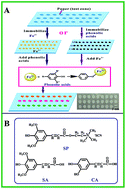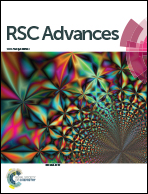Paper-based analytical device with colorimetric assay application to the determination of phenolic acids and recognition of Fe3+†
Abstract
Considering the fact that phenolic acids (PAs) have a versatile activity in vivo and are found to be the most abundant antioxidants in our diet, their detection and quantification is very important for a healthy diet. Herein, we first propose a paper-based analytical device (PAD) for colorimetric detection of PAs and recognition of Fe3+. The PAD is fabricated based on a simple microarray. Specific probes are placed in the test zones on the PAD, followed by the introduction of assay targets. Color response and intensity measurements are directly conducted in the test zones after the completion of the probe-to-target reactions, avoiding the time-consuming integration of external devices and the involvement of chromophoric reagents. The PAD features easy fabrication and operation, low cost, and satisfied sensitivity, which is beneficial for the simple and fast detection of biomolecules.


 Please wait while we load your content...
Please wait while we load your content...